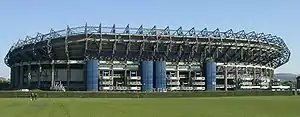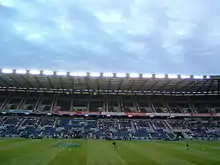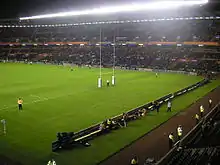Murrayfield Stadium
Murrayfield Stadium (known as BT Murrayfield Stadium for sponsorship reasons, or popularly as Murrayfield) is a sports stadium located in the Murrayfield area of Edinburgh, Scotland. It has a seating capacity of 67,144 making it the largest stadium in Scotland and the fifth largest in the United Kingdom.[1]
 | |
 | |
 BT Murrayfield Stadium Location within Edinburgh | |
| Location | Roseburn Street Edinburgh EH12 5PJ |
|---|---|
| Coordinates | 55°56′32″N 3°14′27″W |
| Public transit | |
| Owner | Scottish Rugby Union |
| Operator | Scottish Rugby Union |
| Capacity | 67,144 |
| Record attendance | 104,000 (1975 Five Nations - Scotland vs Wales) |
| Surface | Desso Grassmaster hybrid pitch |
| Construction | |
| Opened | 1925 |
| Renovated | 1995 |
| Architect | Connor Milligan |
| Tenants | |
| Scottish Rugby Union Edinburgh Rugby (1996–2017),(2018–) Edinburgh Sevens (2007–2011) Scottish Claymores (1995–2002) | |
The stadium is the home of the Scottish Rugby Union (SRU), and is mainly used as a venue for rugby union. The stadium hosts most of Scotland's home test matches, the Scottish Hydro Electric Cup final, as well as Pro14 and European Rugby Champions Cup matches.
Although primarily a rugby union stadium, Murrayfield has in the past hosted American football, rugby league and association football matches, as well as numerous music concerts.
Location
Murrayfield is located next to Murrayfield Ice Rink, Murrayfield Curling Rink, and is close to Edinburgh Zoo. It is named after the area of Edinburgh it is located in, Murrayfield. There are two cricket pitches in the immediate vicinity at Roseburn Park used by Murrayfield DAFS CC (formed from mergers between several local teams)[2] and also four rugby pitches owned by the SRU which were used by teams including the amateur club Murrayfield Wanderers RFC - they and their predecessors had played there since 1902 but were asked to vacate in 2018 as the governing body had plans to develop the land.[3][4] Wanderers moved their training base to Roseburn but continued to hire the Murrayfield pitches for some matches.

Transport
Buses
The stadium is served by Lothian Bus services 12, 22, 26, 31 and the Airlink(100) along Corstorphine Road.[5][6] Post-match traffic congestion is common along this route.
Rail
Despite the line running adjacent to the stadium, the closest railway station to the stadium is Haymarket, which lies a mile to the East.
Interchange with the Edinburgh Trams is available at Haymarket and Edinburgh Park stations. Edinburgh Waverley is a short walk from the St Andrew Square tram stop.
Tram
Murrayfield Stadium tram stop is located adjacent to the stadium entrance turnstiles on Roseburn Street. Access to the platform is by a flight of stairs or lift. As part of crowd-management measures, ticketing machines are situated at the bottom of the staircase and not the platform.
| Preceding station | Edinburgh Trams | Following station | ||
|---|---|---|---|---|
| Haymarket towards York Place |
York Place - Edinburgh Airport | Balgreen towards Airport |
History
The SRU identified 19 acres of land at Murrayfield, purchasing this from Edinburgh Polo Club at Murrayfield, having raised money through debentures.[7] A stand and three embankments were constructed, which took two years.[7] Previous internationals had been played at Inverleith.[8] On 21 March 1925 England were the first team to visit Murrayfield, with 70,000 people watching Scotland beat them to win their first Five Nations Championship Grand Slam.[8]
During the Second World War the ground at Murrayfield was offered to the nation and was taken over by the Royal Army Service Corps and used as a supply depot. During the war years the armed forces sports authorities managed to arrange two Scotland v. England services internationals each year, on a home-and-away basis. Scotland's home matches were played at Inverleith for the first two years with a return to Murrayfield in 1944 after that ground's derequisition.
Murrayfield's record attendance of 104,000 was set on 1 March 1975 when Scotland defeated Wales 12–10 during the 1975 Five Nations Championship.[9] This attendance stood as a world record until 1999.[8]
The East stand was built in 1983.[10]
In October 1991 another debenture scheme was launched, to finance a more comprehensive redevelopment of the West Stand.[11] The new West Stand was designed with a 48-metre cantilever roof.[12] The old West Stand housed a museum, but this was not replaced and plans for a new visitor centre were shelved when the game turned professional.[13] The first phase was completed in January 1993 with the new north and south stands opening.[12] In February 1994 the centre section of the new West Stand opened.[10] In 1994, Murrayfield completed a £50-million renovation where floodlights were installed for the first time.
In October 2012, SRU chief executive Mark Dodson told the BBC that it was actively seeking a name sponsor for Murrayfield:[14]
The single biggest piece of our inventory is our national stadium. We would like to see if we can monetise that. It would be crazy for us not to look at using our single biggest piece of inventory to drive revenue. We want to get the right price for it.
In addition, Dodson indicated that the SRU was actively seeking a site for a completely new stadium with a capacity of 10,000 to 15,000 as a future home for Edinburgh Rugby.[15] The pitch was damaged by nematodes in the lead up to the 2013 autumn internationals. This led the SRU to replace the grass with a Desso surface from the start of the 2014 season.[16] A naming rights deal with BT was agreed in May 2014, resulting in the stadium being officially named as the BT Murrayfield Stadium.[17]
Uses
Rugby union


Murrayfield is used for most Scottish international rugby union matches, with all Scotland's Six Nations home games being played in the stadium. The stadium also hosted all of Edinburgh's matches between 1996 and January 2017. (For Pro14 matches, only the lower tier of the East Stand is typically used.)
Since February 2018 all Edinburgh matches are once again held at Murrayfield; with work on-going on the construction of a new 7,800 capacity stadium on the back pitches to host Edinburgh Rugby from the start of the 2020/21 season.
From 2007 to 2011, Murrayfield hosted the Edinburgh 7s, then the final event in the annual IRB Sevens World Series in rugby sevens, but that tournament was moved to Glasgow starting in 2012 due to low attendance. Murrayfield hosted select matches from the 2007 Rugby World Cup. The stadium also hosted the Heineken Cup Final in 2005, when Toulouse beat Stade Français 18–12, and again in 2009, with Leinster defeating Leicester 19–16.[18]
Rugby World Cup
Murrayfield hosted matches of the 1991, 1999 and 2007 Rugby World Cups.
1991
| Date | Competition | Home team | Away team | Attendance | ||
|---|---|---|---|---|---|---|
| 5 October 1991 | 1991 Rugby World Cup Pool 2 | 47 | 9 | 40,000 | ||
| 9 October 1991 | 1991 Rugby World Cup Pool 2 | 51 | 12 | 35,000 | ||
| 12 October 1991 | 1991 Rugby World Cup Pool 2 | 24 | 15 | 54,000 | ||
| 19 October 1991 | 1991 Rugby World Cup Quarter-final 2 | 28 | 6 | 54,000 | ||
| 26 October 1991 | 1991 Rugby World Cup Semi-final 1 | 6 | 9 | 54,000 | ||
1999
| Date | Competition | Home team | Away team | Attendance | ||
|---|---|---|---|---|---|---|
| 3 October 1999 | 1999 Rugby World Cup Pool A | 29 | 46 | 57,612 | ||
| 8 October 1999 | 1999 Rugby World Cup Pool A | 43 | 12 | 9,463 | ||
| 10 October 1999 | 1999 Rugby World Cup Pool A | 47 | 3 | 4,769 | ||
| 16 October 1999 | 1999 Rugby World Cup Pool A | 40 | 0 | 17,593 | ||
| 20 October 1999 | 1999 Rugby World Cup Quarter-final play-off 3 | 35 | 20 | 20,000 | ||
| 24 October 1999 | 1999 Rugby World Cup Quarter-final 3 | 18 | 30 | 59,750 | ||
2007
| Date | Competition | Home team | Away team | Attendance | ||
|---|---|---|---|---|---|---|
| 18 September 2007 | 2007 Rugby World Cup Pool C | 42 | 0 | 31,222 | ||
| 23 September 2007 | 2007 Rugby World Cup Pool C | 0 | 40 | 64,558 | ||
Rugby league
Although primarily a rugby union stadium, Murrayfield hosted the Rugby League Challenge Cup Finals of 2000 and 2002. The stadium hosted rugby league's Super League Magic Weekend in 2009. The record for a rugby league attendance at the stadium is 67,247 for the 2000 Challenge Cup Final.
Association football
Murrayfield has also hosted association football matches. In December 2003, the SRU board agreed to let local Scottish Premier League side Heart of Midlothian F.C. (Hearts) lease the stadium for match days.[19] Later that month, UEFA confirmed that Hearts' own ground, Tynecastle did not meet the minimum criteria for European matches from the 2004–05 season.[20] Hearts used Murrayfield as their home venue for European matches for three years[21] until Hearts made adjustments to Tynecastle that made it compliant with UEFA regulations.[22] Additionally, both Hearts and Edinburgh neighbours Hibernian have played preseason friendlies against FC Barcelona at Murrayfield.[23][24] Almost 58,000 people attended to watch Hearts play Barcelona in July 2007, recording the largest crowd at a football match in Edinburgh for 51 years.[25]
In 2014, Glasgow club Celtic played two qualifying matches at the stadium due to Celtic Park being unavailable because of Glasgow's hosting of the 2014 Commonwealth Games.[26] Hearts again used the stadium for home games during the 2017–18 Scottish Premiership, due to the delays in construction of a new main stand at Tynecastle.[27] Murrayfield hosted one of the 2018–19 Scottish League Cup semi-finals, played between Hearts and Celtic, in October 2018.[26] That match attracted an attendance of 61,161, the second-largest ever recorded for a football match in Edinburgh.[28] In July 2019, Murrayfield hosted a pre-season friendly between Liverpool and Napoli, that attracted a crowd of 65,442 which was the highest attendance of fans at a football match in Scotland since the 1989 Scottish Cup Final.[29]
American football
Murrayfield has played host to American football and was one of two home venues for the now defunct Scottish Claymores in the NFL Europa between 1995 and 2004, the other being Hampden Park in Glasgow. Additionally, it hosted World Bowl '96 on 23 June 1996. It has been mentioned as a potential future host site for the NFL International Series, should the National Football League add future games outside the series' current permanent home, Tottenham Hotspur Stadium in London. (From 2007 to 2018 the permanent home of the NFL International Series was Wembley Stadium also in London.)
Music
David Bowie played to a capacity crowd of 47,000 people on 28 June 1983.[30] On 30 June 1996, Tina Turner played at Murrayfield as part of her Wildest Dreams Tour. In September 1997 U2 played at Murrayfield as part of their Popmart Tour.[31] On 3 June 1999, The Rolling Stones played to 51,000 on their No Security Tour.[32] On 8 July 1999 Celine Dion performed her Let's Talk About Love World Tour as she sold out the full venue of 67,000, on her first ever show in Scotland. In July 2005, Murrayfield hosted the final Live 8 concert, Edinburgh 50,000 – The Final Push, with performances including James Brown, Texas and The Proclaimers. Oasis played a sold-out show on 17 June 2009, as part of their world tour. Some antisocial behaviour at this event affected the stadium's licensing arrangements when they were reviewed a few months later.[33] This was the last time Oasis would play a concert in Scotland and the second time they had played the stadium, the first being on their Standing on the Shoulder of Giants Tour in 2000.
Bon Jovi performed at the stadium on 22 June 2011 as part of their tour.[34] Madonna performed to a sell-out crowd of 52,160 on 21 July 2012 as part of her MDNA Tour. On 3 June 2014, One Direction performed to over 64,000 fans at Murrayfield as part of their Where We Are Stadium Tour. Foo Fighters performed at Murrayfield Stadium as part of their Sonic Highways World Tour on 8 September 2015. The band were originally supposed to play Murrayfield on 23 June 2015 but this was cancelled and rescheduled after Dave Grohl broke his foot at European Festival that same month. The Spice Girls performed to over 55,000 fans on 8 June 2019 as part of their Spice World tour, it was their first Scottish concert in 21 years.
References
- https://www.telegraph.co.uk/rugby-union/2020/02/10/england-thrash-scotland-freezing-temperatures-murrayfield-ensure/
- Club History, Murrayfield DAFS Cricket Club
- SRU send Wanderers on their way – despite club’s significant investment in Murrayfield estate, The Offside Line, 30 July 2018
- History, Murrayfield Wanderers RFC
- "Getting to BT Murrayfield from Edinburgh City Centre" (PDF). Lothian Buses. Retrieved 22 October 2017.
- "Getting to BT Murrayfield from Edinburgh Airport and Ingliston or Hermiston Park & Ride" (PDF). Lothian Buses. Retrieved 22 October 2017.
- "Changed days as the home of Scottish rugby takes on world of big business From cricket pitch to a cash jackpot". The Herald. 4 March 1995. Retrieved 14 January 2016.
- "Scottish Flashback: Murrayfield in the snow, 1963". The Scotsman. 28 January 2015. Retrieved 13 December 2015.
- "Edinburgh, Roseburn Street, Murrayfield Stadium". Historic Environment Scotland. Retrieved 13 December 2015 – via Canmore.
- "How Murrayfield is growing great". The Herald. 5 February 1994. Retrieved 19 November 2017.
- "The debenture scheme delivers delight". The Herald. 5 February 1994. Retrieved 14 January 2016.
- "Murrayfield is entering a bright new era". The Herald. 13 January 1993. Retrieved 30 October 2017.
- "Return of Murrayfield museum remains beyond SRU's pocket". The Scotsman. 16 July 2010. Retrieved 29 October 2017.
- "Murrayfield could be renamed for right price – Scottish Rugby". BBC Sport. 29 October 2012. Retrieved 30 October 2012.
- "SRU chiefs seek Murrayfield stadium name change sponsor to help pay off debts". The Scotsman. 30 October 2012. Retrieved 30 October 2012.
- "Scots to install hybrid pitch at Murrayfield". Bangkok Post.
- "Scottish Rugby confirms deal for BT Murrayfield Stadium". BBC Sport. 28 May 2014. Retrieved 28 May 2014.
- "Leicester 16–19 Leinster". BBC Sport. 23 May 2008.
- "Hearts get go-ahead for ground switch to Murrayfield". The Scotsman. 4 December 2003. Retrieved 29 October 2017.
- "Tynecastle not fit for Europe". BBC Sport. 22 December 2003. Retrieved 5 January 2013.
- "Hearts 0-2 Sparta Prague". BBC Sport. 14 September 2006. Retrieved 5 January 2013.
- "Tynecastle Stadium: 1981-present". heartsfc.co.uk. Heart of Midlothian FC. Archived from the original on 16 June 2013. Retrieved 5 January 2013.
2005: Plans were produced for a new Main Stand that could take the capacity of the stadium up to 25,000. In the meantime, the removal of 280 seats from the front of the Gorgie and Roseburn Stands allowed the club to extend the length of the playing pitch to meet UEFA Cup requirements. The capacity of the ground is now 17,400.
- "Classy Barcelona toy with Hearts". BBC Sport. 28 July 2007. Retrieved 5 January 2013.
- Grahame, Ewing (25 July 2008). "Hibernian handed six of the best by rampant Barcelona at Murrayfield". Daily Telegraphg. Retrieved 5 January 2013.
- Bean, Graham (5 September 2013). "Champions League: Celtic to play at Murrayfield". The Scotsman. Retrieved 15 May 2014.
- "Liverpool to play friendly against Napoli at Murrayfield in July". BBC Sport. 6 June 2019. Retrieved 6 June 2019.
- Anderson, Barry (3 August 2017). "Hearts to stage games at Murrayfield due to main stand delay". Edinburgh Evening News. Retrieved 4 August 2017.
- Wales, Peter (28 October 2018). "Hearts-Celtic semi-final is second largest football attendance in Edinburgh". Edinburgh Evening News. Retrieved 6 June 2019.
- Lindsay, Matthew (28 July 2019). "Liverpool 0 Napoli 3: Champions League winners slump to heavy defeat at Murrayfield". The Herald. Retrieved 4 August 2019.
- "Acclaim in the rain". The Glasgow Herald. 29 June 1983. p. 1. Retrieved 24 October 2017.
- "U2 criticised for holding Murrayfield concert". The Herald. 3 September 1997. Retrieved 29 October 2017.
- "The Stones (and the years) roll on". BBC News. 4 June 1999. Retrieved 24 October 2017.
- "Murrayfield ordered to bid for booze licence before every gig". The Scotsman. 18 August 2009. Retrieved 24 October 2017.
- "Bon Jovi Live 2011 Tour Page". Island Records. Archived from the original on 27 July 2011.
External links
| Wikimedia Commons has media related to Murrayfield Stadium. |
| Preceded by None |
Rugby World Cup Sevens host venue 1993 |
Succeeded by Hong Kong Stadium Hong Kong |
| Preceded by Twickenham London |
Heineken Cup final venue 2004–05 |
Succeeded by Millennium Stadium Cardiff |
| Preceded by Millennium Stadium Cardiff |
Heineken Cup final venue 2008–09 |
Succeeded by Stade de France Paris |
| Preceded by Parc Olympique Lyonnais Lyon |
European Rugby Champions Cup Final Venue 2016–17 |
Succeeded by San Mamés Stadium Bilbao |
| European Rugby Challenge Cup Final Venue 2016–17 |